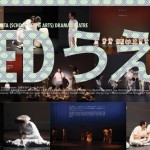“The Malay Man and His Chinese Father”
Reviewer: Beverly Yuen
Performance: 17 January 2015
As the audience step into the theatre, the two protagonists—the Chinese father (played by Michael Tan) and the Malay son (played by Yazid Jalil)—are already standing on the t-shaped stage in their briefs, with audience placed on both sides of the stage. As the performance begins, they started to touch each other: at times resembling an embrace, at times a wrestle, at times a struggle to arrive at a common understanding. The father and son then went into a sequence of taking turns to carry each other. Gradually, another character, the Malay wife/mother is mentioned by the two. The father missed the lost wife and sees her in the son. He rekindles the memory of the beloved wife by dressing the son in the wife’s kebaya. The son could only reenact his mother through his father’s gaze and touch.
Silence plays a major role in creating tension and the sense of repressed anger between father and son while recovering their lost memory of a wife and a mother. The protagonists do not speak other than the repeated humming of the Chinese childhood song “Mom is the Best in the World” by the father. There is a very powerful image of the father resting on the son’s laps. Traditionally, we often see the depiction of a son on a mother’s laps—from folk drawings to religious depiction of Mother Mary and her dying son. The image of a father on the son’s laps questions the identity of the two. Who is the parent and who is the child? Director Noor Effendy interrogates gender and traditional familial roles here.
Vocal artist Asnida Daud generated an array of vocal displays—from chant-like singing to low-pitched alaryngeal voice to soothing sounds to coarse and cracking voice. All this accentuates the helplessness and aching state of reminiscences that the characters are experiencing; and form concrete images of the return of the “ghost” of the wife and the physical manifestation of the hysterical state of search and loss.
The lighting designer Mohd Fita Helmi plays with shadows in a simple and yet intelligent manner. Shadows of the performers were constantly cast on the walls, which suggests that there was something darker and deeper beyond the physical appearance of the two characters. At times, the shadows of the performers were magnified on the walls, as if there was a higher being or a third party observing their lives.
Both the performers were able to sustain the one-hour performance with intensity: from excellent control of their physical movement to the portrayal of inner emotions. The haunting and overwhelming impact of the memory that returns to them escalates as the play progresses. The son, who knows almost nothing about his mother, eventually tires of the game. The father, obsessed with the memory of the wife, persists in finding a door to the wife through the son.
Overall, the intimate stories of the father and son are communicated strongly without words. It is a powerful piece about the search of identity, lost memory and sacrifice. However, I wish that there were some lighter moments in the process of the search.
Do you have an opinion or comment about this post? Email us at info@centre42.sg.
ABOUT THE PRODUCTION
THE MALAY MAN AND HIS CHINESE FATHER by ponggurl
17 – 18 January 2015
Gallery Theatre, National Museum of Singapore
Free: Durational Performance 3pm – 6pm
On 17 Jan, The Story of the Malay Man
On 18 Jan, The Story of the Chinese Father
ABOUT THE REVIEWER
Beverly Yuen is an arts practitioner, and co-/founder of Theatre OX and In Source Theatre. She keeps a blog at beverly-films-events.blogspot.sg.





